Life in Beijing – Sanlitun
Monday, July 26th, 2010 in: News, Travel
Sanlitun, just off the third ring road, is a slightly more grown-up Wudaokou. An even greater hub for foreign revelers and lushes, Sanlitun is full of shopping malls, restaurants, bars and night-clubs. The latter attracts a majority of the night scene, which interests me little although I’ve had some chance to experience it. While no clubs are quite as seedy and crowded as Propaganda in Wudaokou (OK, some of them are), some of them are still quite fun. I was warned to avoid shots, especially the vials they pass out at the dance clubs–they either water down their liquor, or put something sinister in it. Vic’s, Mix, Lantern, I’ve only been to a handful of Sanlitun night clubs. I couldn’t see myself going there with much frequency, mostly for the cost, but also because I lacked the will to maneuver through crowds of drunken revelers walking the fine line between their adulthood and their immaturity, looking for some street food to fuel my own eternal youth. As much fun as can be had in this place, there are just moments when I can’t help but realize that it’s just a distraction.
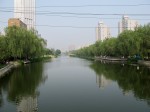 Though a night in Sanlitun is going to cost a considerable bit more than other parts of town, the value doesn’t always add up. Off the main section are several sad little establishments that are miraculously still in business for whatever reason. The Boat Bar moored to the concrete shore of the stagnant canal, with its watered-down, overpriced drinks, is one great example; its deck so poorly lit that you’re either sitting in complete darkness or in front of a floodlight, as if you’re being interrogated by the police. Just down the canal is a wine bar that is even more pathetic; completely empty other than our group when we took pity on it in passing and decided to duck in for a drink. Their drinks were so feebly mixed our pity quickly dissipated and was quickly replaced with frothy disdain that sent us tumbling back into the street.
Though a night in Sanlitun is going to cost a considerable bit more than other parts of town, the value doesn’t always add up. Off the main section are several sad little establishments that are miraculously still in business for whatever reason. The Boat Bar moored to the concrete shore of the stagnant canal, with its watered-down, overpriced drinks, is one great example; its deck so poorly lit that you’re either sitting in complete darkness or in front of a floodlight, as if you’re being interrogated by the police. Just down the canal is a wine bar that is even more pathetic; completely empty other than our group when we took pity on it in passing and decided to duck in for a drink. Their drinks were so feebly mixed our pity quickly dissipated and was quickly replaced with frothy disdain that sent us tumbling back into the street.
 On the brighter side of mixology are a few shining stars in the constellation of liquor licenses that constitutes Sanlitun proper; the two worth mentioning I wish I could say I’d been to more than once; Apothecary and Opposite House. Apothecary, a decidedly cool name for a bar to begin with, really takes its drinks seriously, from hand-chipped ice to hand-picked ingredients; even their bartenders sport prestigious pedigrees on their resumes. The menu is lovingly crafted with paragraph-long explanations of the heritage of their drinks, and their concoctions conjure a sense of respect for the ingredients.
On the brighter side of mixology are a few shining stars in the constellation of liquor licenses that constitutes Sanlitun proper; the two worth mentioning I wish I could say I’d been to more than once; Apothecary and Opposite House. Apothecary, a decidedly cool name for a bar to begin with, really takes its drinks seriously, from hand-chipped ice to hand-picked ingredients; even their bartenders sport prestigious pedigrees on their resumes. The menu is lovingly crafted with paragraph-long explanations of the heritage of their drinks, and their concoctions conjure a sense of respect for the ingredients. 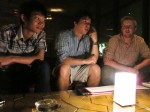 Their Earl Grey Martini is really something else. There’s good reason Apothecary has received much acclaim from the various expat rags in Beijing, I only wish I could afford to go there more often. Opposite House is a cool, modern, downbeat bar in a relaxed atmosphere. Much like Apothecary, the quiet ambiance and intriguing architecture betrays an attention to detail that makes it a pleasant experience. Their black pepper pineapple cocktail was quite memorable; weeks later, I can still taste the bite of pepper cutting through the sweetness of the pineapple. My only complaint was the poor application of light to the environment–I had to pick up a table light and hold it up to a menu so I could read it.
Their Earl Grey Martini is really something else. There’s good reason Apothecary has received much acclaim from the various expat rags in Beijing, I only wish I could afford to go there more often. Opposite House is a cool, modern, downbeat bar in a relaxed atmosphere. Much like Apothecary, the quiet ambiance and intriguing architecture betrays an attention to detail that makes it a pleasant experience. Their black pepper pineapple cocktail was quite memorable; weeks later, I can still taste the bite of pepper cutting through the sweetness of the pineapple. My only complaint was the poor application of light to the environment–I had to pick up a table light and hold it up to a menu so I could read it.
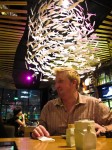 Not all of the fun here is alcohol-induced. The real pleasure to be found in Sanlitun lies in food, the other hedonist’s delight. Sanlitun is home to some of my finer dining experiences in Beijing, although it has been a mixed bag. An Arabic restaurant just across the road from the Boat Bar had some lovely dishes, even offering roasted pigeon or a whole goat if you were so inclined. Morel’s, a Belgian restaurant, had a fine stew and the finest mussels I’ve had in Beijing. I was reluctant to try them–seafood in Beijing is a sucker’s bet–but I was surprised when I finally relented by how fresh and tender they were. They put the mussels in the seafood pasta
Not all of the fun here is alcohol-induced. The real pleasure to be found in Sanlitun lies in food, the other hedonist’s delight. Sanlitun is home to some of my finer dining experiences in Beijing, although it has been a mixed bag. An Arabic restaurant just across the road from the Boat Bar had some lovely dishes, even offering roasted pigeon or a whole goat if you were so inclined. Morel’s, a Belgian restaurant, had a fine stew and the finest mussels I’ve had in Beijing. I was reluctant to try them–seafood in Beijing is a sucker’s bet–but I was surprised when I finally relented by how fresh and tender they were. They put the mussels in the seafood pasta 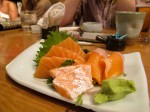 I’d had at the Intercontinental Hotel in Olympic Park (which were dry and overpriced, AND they pulled the expensive bottled water trick on us) to shame. Last but not least is Hatsune, a Japanese restaurant with a dreamy interior with schools of white fish sculptures dancing across the ceiling against waves of curved wood beams. Their sushi, a mixture of traditional and American-style rolls, was some of the best I’ve ever had. Their tempura was on target, light and fluffy with no heavy oil taste. There were no disappointments in that meal, except when the bill came, but even 160 RMB ($25 US), although the most I’d spent on a meal in Beijing, was well worth the meal.
I’d had at the Intercontinental Hotel in Olympic Park (which were dry and overpriced, AND they pulled the expensive bottled water trick on us) to shame. Last but not least is Hatsune, a Japanese restaurant with a dreamy interior with schools of white fish sculptures dancing across the ceiling against waves of curved wood beams. Their sushi, a mixture of traditional and American-style rolls, was some of the best I’ve ever had. Their tempura was on target, light and fluffy with no heavy oil taste. There were no disappointments in that meal, except when the bill came, but even 160 RMB ($25 US), although the most I’d spent on a meal in Beijing, was well worth the meal.
The heart of Sanlitun is the international scene, fueled by the plethora of embassies that call it home. As such, there are many establishments there to anticipate and cater to the needs of the expat community in Beijing. Most notable of which is Jenny Lou’s, a supermarket with goods from all over the world. Having been stuck with the strange smell and selection at standard Chinese markets, it was literally a breath of fresh air to walk into Jenny Lou’s and smell freshly baked bread. They boasted an impressive selection of wines and beers and other beverages from around the globe, with a wall of cereal with selections I’d never before seen. The cost of nostalgia is quite high these days–I spent around 300 RMB on goods that I spread out over a barbecue and 3 or 4 meals. I only recovered about a third of what I’d spent, but I chalked it up to the cost of taking the initiative and enjoying a little piece of home. I spotted a bottle of vegemite and texted my Australian friend if he was interested in spending 60 kuai for the 220g container, to which he replied with an emphatic “Yea!!!!!”
Sometimes, the value outweighs the cost.

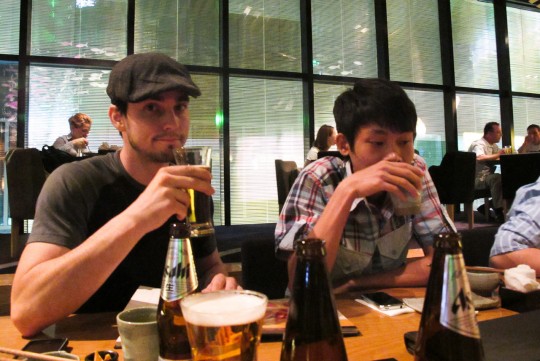







Earl Grey Martini = my kind of thing! I wonder how they made it…